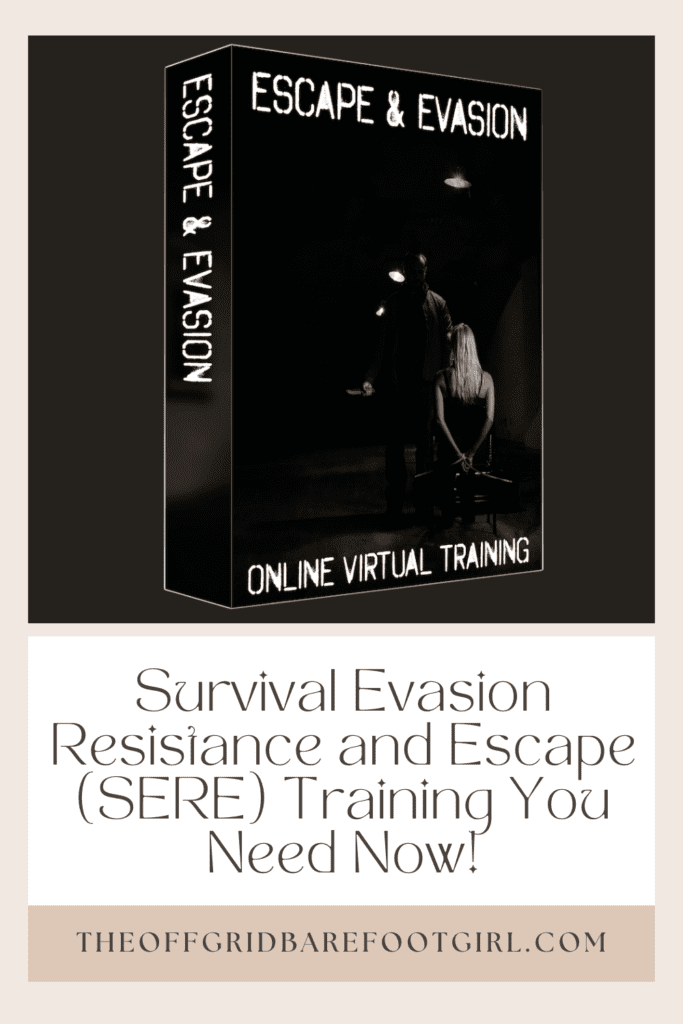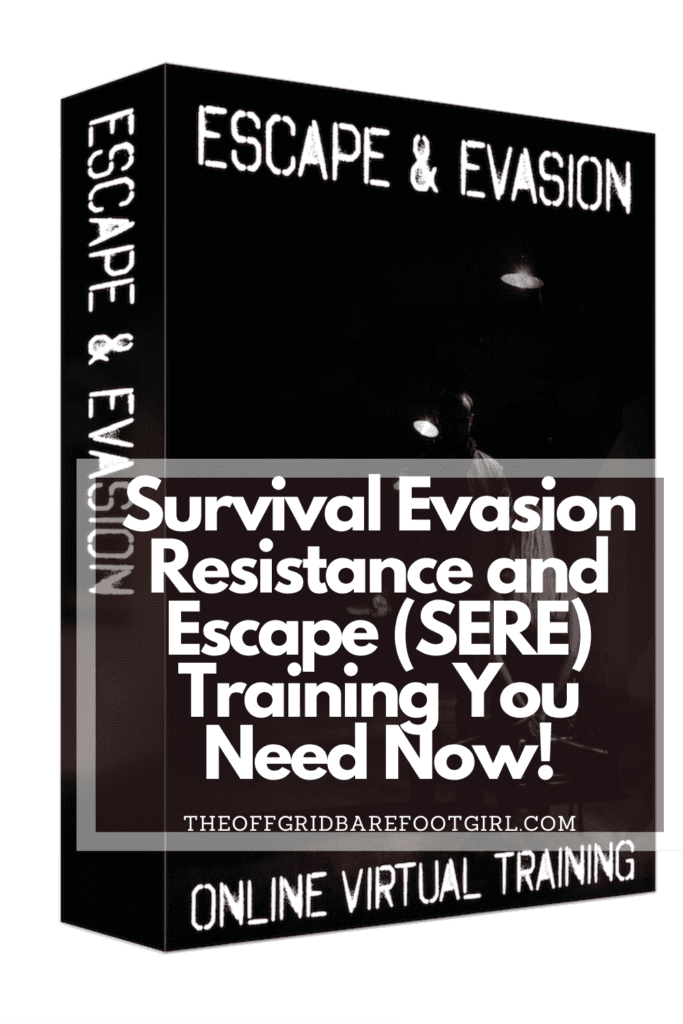Survival evasion resistance and escape. Starring Jack Richland! (View the course trailer!)
Imagine this: You’re out in the wilderness, miles from civilization, with no food or water. Or perhaps you find yourself in hostile territory, captured by enemy forces. Suddenly, all those survival shows you’ve watched take on a whole new level of importance. That’s where SERE (Survival, Evasion, Resistance, and Escape) training comes in – a comprehensive program designed to equip you with the skills to survive and thrive in the most extreme situations.
Whether you’re an outdoor enthusiast, a member of the military, or simply someone who wants to be prepared for the unexpected, SERE training could be a literal lifesaver. From learning how to find food and water in the wild to mastering evasion techniques and resistance strategies, this training covers a wide range of invaluable skills that could make all the difference in a crisis.
What SERE Training Emphasizes

But SERE isn’t just about physical survival – it’s also about mental toughness and the ability to stay calm under pressure. After all, when you’re facing life-or-death situations, your mindset can be just as crucial as your practical skills. That’s why SERE training emphasizes mental preparedness and resilience, giving you the tools to overcome even the most daunting challenges.
In this comprehensive guide, I’ll be discussing the core components of SERE training, exploring everything from basic survival skills to advanced escape methods. You’ll learn how to prepare for the rigors of SERE, what to expect during the training, and why continuous practice is essential. Get ready to unlock a whole new level of preparedness and confidence, because when it comes to survival, knowledge truly is power!
This is a pinnable post. Tap or hover over any image in this post to pin to your Pinterest Boards.

Enroll In The Escape and Evasion Survival Training Course

Who Is Jack Richland?
Jack Richland is a prominent figure in the survival and preparedness community, known for his extensive knowledge and expertise in Survival, Evasion, Resistance, and Escape (SERE) training. As a former member of the U.S. military, Richland has leveraged his firsthand experience and training to educate others on essential survival skills.
He is the founder of Black Scout Survival, a platform dedicated to providing practical advice, tutorials, and gear reviews for those looking to enhance their self-reliance and preparedness. Richland’s work is highly regarded for its thoroughness and practicality, making him a trusted resource for anyone interested in survival tactics and strategies.
Visit his website by clicking this link to learn more about him.
Escape and Evasion with Jack Richland

What is SERE Training?
Survival, Evasion, Resistance, and Escape (SERE) training is a comprehensive program designed to equip individuals with essential skills for surviving in hostile environments and evading capture by enemy forces. This specialized training is crucial for those who may find themselves in high-risk situations, such as military personnel, pilots, and certain civilian professionals.
Definition and Purpose of SERE Training
SERE training encompasses a wide range of topics, including wilderness survival techniques, evasion tactics, resistance methods, and escape strategies. The primary purpose of this training is to prepare individuals for scenarios where they may be isolated, captured, or held captive in hostile environments. By learning these skills, they increase their chances of survival and safe return.
Who Needs SERE Training?
While SERE training is mandatory for certain professions, it can be beneficial for anyone who engages in high-risk activities or travels to remote or potentially dangerous areas. Military personnel, aviators, and intelligence officers are among the primary recipients of this training due to the inherent risks associated with their roles. Additionally, civilians involved in activities such as outdoor exploration, humanitarian aid work, or journalism in conflict zones may find SERE training valuable.
Importance of SERE Training in Survival Situations
In survival situations, having the knowledge and skills imparted by SERE training can mean the difference between life and death. By learning how to navigate unfamiliar terrain, find food and water sources, construct shelters, and evade potential threats, individuals increase their chances of surviving until rescue or extraction. Furthermore, resistance and escape techniques can help individuals endure captivity and potentially escape from hostile forces.
SERE training not only provides practical skills, but also instills a mental toughness and resilience that can be invaluable in extreme circumstances. Participants learn to manage stress, maintain situational awareness, and adapt to rapidly changing environments – all crucial elements for survival in hostile or austere conditions.
Whether faced with natural disasters, armed conflicts, or other life-threatening situations, the knowledge and skills acquired through SERE training can empower individuals to take control and increase their chances of survival and safe return. It is a valuable investment for anyone who may find themselves in high-risk environments or situations where survival skills could be the key to overcoming adversity.
Core Components of SERE Training

Surviving in hostile environments or evading enemy capture requires specialized training. That’s where SERE (Survival, Evasion, Resistance, and Escape) comes into play. This comprehensive program equips individuals with essential skills and strategies to navigate life-threatening situations. Let’s explore the core components that make up this invaluable training.
Survival Skills
The survival aspect of SERE focuses on equipping you with the knowledge and techniques necessary to sustain yourself in various environments, from dense jungles to arid deserts. You’ll learn how to find and purify water, forage for edible plants, construct shelters, and build fires. Additionally, you’ll gain insights into navigating using natural cues, signaling for rescue, and basic first aid.
Evasion Techniques
Evasion is a crucial component of SERE training, teaching you how to avoid capture or detection by hostile forces. You’ll learn techniques for moving stealthily, camouflaging yourself, and leaving minimal traces. Understanding terrain analysis, map reading, and land navigation skills are also key elements of successful evasion.
Resistance Tactics
In the event of capture, resistance tactics prepare you to withstand interrogation and maintain your integrity. SERE training covers methods for resisting exploitation, including techniques for controlling stress, maintaining a strong mindset, and employing counter-interrogation strategies. Understanding the Geneva Conventions and your rights as a prisoner of war is also emphasized.
Escape Methods
While the primary focus is on evading capture, SERE training also equips you with escape methods should you find yourself in a captive situation. You’ll learn techniques for escaping restraints, breaching confined spaces, and navigating unfamiliar environments. Additionally, you’ll gain insights into improvising tools and weapons from everyday objects, as well as strategies for evading recapture.
“The ultimate measure of a man is not where he stands in moments of comfort and convenience, but where he stands at times of challenge and controversy.” – Martin Luther King Jr.
By mastering these core components, SERE training empowers individuals with the knowledge and skills to survive, evade, resist, and ultimately escape even the most dire circumstances. Whether you’re a military personnel, an adventurer, or someone seeking to prepare for emergencies, this comprehensive training can be a lifeline in the face of adversity.
Preparing for SERE Training

Preparing for a Survival Evasion Resistance and Escape (SERE) training is a challenging endeavor that demands thorough preparation, both physically and mentally. This comprehensive training program is designed to equip individuals with the skills and knowledge to survive and evade while in hostile environments, resist exploitation, and ultimately escape from captivity. Before discussing the intense strategies of SERE, it’s crucial to take the necessary steps to ensure you’re ready for the grueling challenges ahead.
Physical and Mental Readiness
SERE training is an intense and demanding experience that pushes participants to their limits. Physical preparation is paramount, as you’ll be exposed to various environmental stressors, endurance tests, and survival scenarios. Engage in a well-rounded fitness routine that incorporates cardiovascular exercises, strength training, and flexibility work to build the necessary stamina and resilience.
Mental fortitude is equally important. SERE training can be psychologically taxing, and you’ll need to cultivate a strong mindset to overcome the challenges. Practice stress-management techniques, such as meditation or visualization exercises, to develop the mental toughness required to handle stressful situations calmly and effectively.
Essential Gear and Equipment
While the training facility will provide you with essential survival gear, it’s wise to familiarize yourself with the equipment you’ll be using. Familiarize yourself with items like fire-starting tools, water purification systems, navigation aids, and emergency shelter materials. Understanding how to use these tools effectively can make a significant difference in your ability to survive and thrive in the training environment.
Understanding the Training Environment
SERE training often takes place in remote and challenging environments, such as deserts, mountains, or wilderness areas. Researching the potential training locations and their unique challenges can give you a valuable head start. Study the local climate, terrain, flora, and fauna to better prepare for the conditions you may encounter. Additionally, familiarize yourself with the principles of land navigation, shelter construction, and foraging to enhance your survival skills.
“By failing to prepare, you are preparing to fail.” – Benjamin Franklin
Proper preparation is the foundation for success in SERE training. By dedicating time and effort to physical and mental readiness, mastering essential gear and equipment, and understanding the training environment, you’ll be better equipped to face the challenges ahead with confidence and resilience. Remember, the more prepared you are, the greater your chances of excelling in this demanding, yet rewarding, experience.
Survival Skills Covered in Escape and Evasion with Jack Richland

Camouflage and Concealment
Techniques for blending into various environments to avoid detection are crucial for effective escape and evasion. This involves understanding how to use natural and artificial materials for camouflage, adapting clothing and gear to match the surroundings, and learning how to move stealthily to minimize noise and visible traces. It also includes the ability to recognize and utilize terrain features to break up your silhouette, use shadows to stay hidden and alter your appearance to blend in with different backgrounds.
Additionally, understanding the behavior of the local wildlife and how to avoid disturbing them can prevent giving away your position. Mastering these techniques can significantly enhance your ability to remain undetected in diverse environments, whether in dense forests, open fields, or urban landscapes.
Tracking and Counter-Tracking
Methods for identifying and evading trackers are essential for anyone learning escape and evasion skills. First, understanding the signs that you are being followed is crucial; this can include noticing repeated patterns of movement or spotting the same individuals or vehicles in different locations. Once identified, you can employ various tactics to evade them. This includes doubling back on your route to confuse pursuers, moving through difficult terrain like dense brush or rocky areas to obscure your tracks, and crossing water bodies to break the scent trail if you suspect you are being tracked by dogs.
Additionally, using counter-tracking techniques such as brushing out your footprints, walking on hard surfaces, or creating false trails can mislead and slow down trackers. Understanding how to recognize and avoid common tracking methods helps in staying one step ahead and effectively evading capture.
Urban Escape and Evasion
Strategies for navigating and hiding in urban settings are vital for effective escape and evasion in city environments. One key approach is to use the complexity of urban landscapes to your advantage, such as by moving through crowded areas to blend in with the populace and avoiding open spaces where you can be easily spotted. Utilizing public transportation systems to change locations quickly and unpredictably can also help evade pursuers.
When it comes to hiding, look for places that offer both cover and concealment, like abandoned buildings, alleyways, or dense foliage in parks. Understanding how to access rooftops, basements, and utility corridors can provide additional escape routes and hideouts. It’s also important to be aware of surveillance cameras and patrol patterns, using knowledge of these to avoid detection.
Furthermore, altering your appearance with changes in clothing or accessories can help you avoid recognition. By mastering these urban navigation and concealment strategies, you can effectively avoid capture in densely populated and monitored areas.
Rural and Wilderness Survival

Skills for finding food, water, and shelter in natural environments are fundamental for survival when isolated from modern conveniences. For finding water, techniques include identifying natural sources such as streams or rivers, collecting rainwater, or using methods like solar stills to extract moisture from the soil.
Recognizing signs of water sources, such as lush vegetation or animal tracks, can also be helpful. For food, knowledge of edible plants, insects, and foraging techniques is essential. This includes being able to identify and harvest wild fruits, nuts, and roots, and knowing how to safely catch and prepare small game or fish.
Building effective shelters involves understanding how to use natural materials like branches, leaves, and mud to create structures that provide protection from the elements. Techniques for insulating and elevating the shelter off the ground can improve comfort and safety. By mastering these skills, you can increase your chances of surviving and thriving in various natural environments.
Lock Picking and Restraint Escapes

Techniques for escaping from handcuffs, zip ties, and other restraints are crucial for regaining freedom in a crisis situation. One common method for handcuff escape involves using a shim or improvised tool to bypass the locking mechanism, though this requires practice and precision.
For zip ties, techniques include applying pressure to the tie while twisting or using a sharp object to cut through it. Another effective method is to use body movements to stretch and break the zip tie or to exploit weak points in the material.
For both types of restraints, learning to control and manipulate your body to maximize leverage and minimize resistance can aid in escape. Additionally, having a basic understanding of restraint construction can help in identifying potential weaknesses or mechanisms for release. Practicing these techniques in a controlled environment can improve your speed and efficiency in real-life situations, enhancing your overall ability to free yourself when needed.
Improvised Tools and Weapons
Creating and using tools and weapons from available materials involves resourcefulness and ingenuity to craft effective solutions for survival and self-defense. This starts with assessing your surroundings for usable materials such as wood, metal, stone, or plastic. For tools, you might fashion a cutting edge from sharp rocks or metal shards, create a fire-starting device using friction techniques or improvised flint, or build a shelter with sturdy branches and vines. Weapons can include simple designs like slingshots made from rubber and wood or spears sharpened from sticks.
Additionally, understanding how to effectively use these tools and weapons, including proper handling and maintenance, is crucial for ensuring their reliability and safety. By leveraging everyday materials and applying basic crafting skills, you can enhance your ability to address immediate needs and challenges, whether in survival scenarios or as part of your overall preparedness strategy.
Physical Fitness and Endurance
Training routines to enhance stamina and physical capabilities for evasion are essential for maintaining the endurance and strength needed to outlast and outmaneuver potential threats. Effective routines should include a mix of cardiovascular exercises, such as running, cycling, or swimming, to build overall endurance and improve aerobic capacity. Strength training exercises, including weightlifting, bodyweight exercises like push-ups and squats, and functional movements such as sprints and agility drills, are important for developing muscle strength and power. Flexibility and mobility exercises, such as stretching and yoga, can help prevent injuries and improve your ability to move fluidly.
Incorporating interval training can also simulate the bursts of effort required during high-stress situations. Regularly practicing these exercises, combined with simulated escape drills and obstacle courses, can significantly enhance your physical preparedness for evasion scenarios, ensuring that you can perform effectively under pressure.
Mental Preparedness and Stress Management
Maintaining focus and resilience under high-stress conditions is crucial for navigating and overcoming challenging situations effectively. Techniques for building mental toughness include practicing mindfulness and meditation to enhance your ability to stay calm and centered. Developing problem-solving skills through scenario-based training helps improve your ability to think clearly and make decisions under pressure.
Additionally, setting small, manageable goals and progressively tackling more complex challenges can build confidence and reduce stress. Regular exposure to high-stress simulations, such as survival drills or timed exercises, can help acclimate your mind and body to stress, enhancing your resilience. Cultivating a positive mindset and employing stress management strategies, such as deep breathing exercises or visualization techniques, can also contribute to maintaining focus and emotional stability. By integrating these practices into your routine, you can improve your capacity to handle crises with composure and effectiveness.

Using maps, compasses, and natural indicators to find your way involves applying fundamental navigation techniques that are critical for orientation in unfamiliar environments. Maps provide a visual representation of terrain features, landmarks, and topographic details, which are essential for planning routes and understanding geographic context. When using a map, it is crucial to identify and match identifiable features in the terrain with those depicted on the map to ensure accurate positioning.
A compass serves as a tool for determining direction and orienting the map. It operates based on the Earth’s magnetic field, indicating magnetic north. To use a compass effectively, align the map’s north with the compass needle, then use the compass to navigate by following bearings or headings that correspond with the map.
Natural indicators, such as the position of the sun, the growth patterns of vegetation, and the direction of water flow, provide additional navigational cues. For example, in the Northern Hemisphere, the sun rises in the east and sets in the west, which can be used to approximate direction. Vegetation often grows denser on southern slopes in temperate regions due to increased sunlight. Observing these natural elements can complement map and compass use, offering additional orientation aids.
Incorporating these tools and techniques improves navigational accuracy and effectiveness in both wilderness and urban settings, supporting successful route planning and orientation.
First Aid and Medical Skills
Basic medical knowledge for treating injuries and illnesses in the field is crucial for managing health issues when professional medical assistance is not immediately available. This includes understanding how to perform basic first aid procedures, such as cleaning and dressing wounds to prevent infection, applying pressure to control bleeding, and immobilizing fractures or sprains to prevent further injury. Knowledge of CPR and basic life support techniques is essential for handling severe emergencies like cardiac arrest or respiratory distress.
Additionally, recognizing and treating common field illnesses, such as dehydration, heat exhaustion, or hypothermia, can prevent more serious complications. Stocking a well-equipped first aid kit and being familiar with its contents, including antiseptics, bandages, splints, and medications, is also important. Knowing how to use these supplies effectively, combined with basic knowledge of symptoms and treatment protocols, enhances your ability to provide immediate care and manage health issues until you can access professional medical help.
Signal Techniques
Methods for signaling for help while remaining hidden from threats involve using discreet yet effective techniques to attract attention without compromising your safety. One common method is to use a signal mirror or reflective surfaces to create a visual signal that can be seen from a distance while ensuring that the reflection is directed away from potential threats. For audio signals, a whistle or signaling device can be used intermittently to avoid detection, as sound travels further in open areas, but can be muffled by obstacles.
Additionally, creating an emergency signal using natural materials, such as arranging rocks or logs in a recognizable pattern like SOS, can be effective when viewed from above by aerial searchers. Another approach involves using light signals, such as a flashlight or glow sticks, with short bursts to minimize visibility. Employing smoke signals or fires, if done cautiously, can also attract attention, but should be managed carefully to avoid revealing your location. Combining these methods with careful observation of surroundings and maintaining a low profile can help ensure that you signal for help effectively while minimizing the risk of detection by adversaries.
Escape Routes and Planning
Developing and practicing escape plans for various scenarios involves a strategic approach to ensure readiness and effectiveness in real situations. Start by assessing potential threats and identifying various scenarios, such as home invasions, natural disasters, or civil unrest, and then create detailed plans tailored to each situation. This includes mapping out multiple escape routes, selecting safe meeting points, and preparing emergency supplies and tools that can be quickly accessed. Practice these plans regularly through drills to familiarize yourself with the procedures, refine your strategies, and improve your speed and efficiency. During drills, simulate different conditions and challenges to test the resilience of your plans and adapt them as needed.
Additionally, ensure that all family members or team members are aware of the plans and know their roles and responsibilities. By routinely practicing and updating your escape plans, you enhance your ability to react swiftly and effectively in various emergencies, increasing your chances of a successful and safe escape.
Other Survival Skills Covered in SERE Training

When it comes to survival situations, having the right skills can make all the difference between life and death. SERE (Survival, Evasion, Resistance, and Escape) training equips individuals with essential survival techniques to navigate even the harshest environments. In this section, I’ll explore some of the critical survival skills covered in SERE training.
Finding Water and Food Sources
Securing a reliable water and food supply is crucial for survival. SERE training teaches you how to identify and purify water sources, as well as forage for edible plants and hunt for game. You’ll learn techniques like building improvised water filters, setting traps, and identifying poisonous plants to avoid.
Building Shelter and Fire
Having shelter and warmth can protect you from the elements and potential threats. SERE training covers the construction of various types of shelters using natural materials and the skills to start and maintain a fire, even in damp conditions. You’ll learn techniques like building debris shelters, creating fire from friction, and using a solar still to collect water.
Getting lost in the wilderness can be disastrous. SERE training equips you with navigation skills, including map reading, using a compass, and identifying natural landmarks. You’ll also learn techniques for signaling rescue teams and leaving trail markers to aid in your rescue.
First Aid and Self-Care
Injuries and illnesses can quickly become life-threatening in survival situations. SERE training covers basic first aid techniques, such as treating wounds, preventing infection, and splinting fractures. You’ll also learn how to monitor your physical and mental health, as well as techniques for managing stress and maintaining morale.
Throughout SERE training, you’ll be challenged with realistic scenarios and hands-on exercises to test your survival skills. By mastering these essential techniques, you’ll be better prepared to face unexpected situations and increase your chances of survival in even the most extreme environments.
Resistance Strategies in SERE Training

In high-risk situations, the ability to resist interrogation, maintain mental toughness, escape captivity, and survive in hostile environments can mean the difference between life and death. SERE (Survival, Evasion, Resistance, and Escape) training equips individuals with essential strategies to overcome these challenges. Let’s explore some critical resistance strategies taught in SERE training.
Resisting Interrogation
Resisting interrogation is a crucial skill, especially for those in the military or high-risk professions. SERE training teaches techniques to control the flow of information, avoid divulging sensitive data, and withstand psychological and physical pressure. For instance, you’ll learn how to employ resistance postures, such as providing a cover story or remaining silent, to thwart an interrogator’s efforts.
Maintaining Mental Toughness
Captivity can be an intense psychological ordeal. SERE training focuses on developing mental toughness and resilience to endure isolation, deprivation, and potential torture. Techniques like stress inoculation and cognitive restructuring help individuals reframe their mindset, control their emotions, and maintain a positive outlook in the face of adversity.
Escaping Captivity
Should you find yourself in a captive situation, SERE training provides valuable insights on how to plan and execute an escape. You’ll learn evasion tactics, such as how to move stealthily, navigate unfamiliar terrain, and avoid detection. Additionally, you’ll practice escape techniques, including picking locks, concealing your movements, and improvising tools from available resources.
Surviving in Hostile Environments
SERE training also equips you with survival skills to endure harsh and hostile environments. You’ll learn how to find water, forage for food, construct shelter and navigate using natural cues. Furthermore, you’ll gain knowledge on signaling techniques to increase your chances of rescue, as well as medical self-aid to treat injuries and illnesses in the field.
“The ultimate measure of a man is not where he stands in moments of comfort and convenience, but where he stands at times of challenge and controversy.” – Martin Luther King Jr.
SERE training isn’t just about physical survival; it’s also about developing the mental fortitude to overcome extreme situations. By mastering resistance strategies, individuals can increase their chances of surviving and prevailing in the face of adversity, whether in the line of duty or unexpected circumstances.
Escape Methods Taught in SERE Training

In the world of SERE (Survival, Evasion, Resistance, and Escape) training, learning effective escape methods is crucial. Whether you’re a military personnel, a first responder, or someone keen on being prepared for emergencies, these techniques can be life-saving. Let’s discuss the various escape methods taught in SERE training.
Improvised Tools and Weapons
One of the key aspects of SERE training is teaching you how to improvise tools and weapons from everyday objects or materials found in your environment. This could involve fashioning a makeshift knife from a piece of metal or creating a slingshot using a sturdy branch and a piece of cloth. The ability to think creatively and resourcefully can be a game-changer in survival situations.
Escape and Evasion Plans
Developing a well-thought-out escape and evasion plan is essential in SERE training. You’ll learn how to assess your surroundings, identify potential escape routes, and develop contingency plans. This includes studying maps, understanding the terrain, and practicing navigation techniques to increase your chances of successfully evading capture or reaching a safe location.
Self-Rescue Techniques
In some scenarios, you may need to rely solely on your own skills and knowledge to escape a dangerous situation. SERE training equips you with self-rescue techniques, such as picking locks, breaking restraints, or scaling walls and fences. These skills can be invaluable when faced with captivity or confinement.
Extraction and Rescue Operations
While self-rescue is crucial, SERE training also covers extraction and rescue operations. You’ll learn how to signal for help, communicate with rescue teams, and follow specific protocols to ensure a successful extraction. This could involve using visual or auditory signals, understanding rendezvous procedures, or even basic medical training to stabilize yourself or others until help arrives.
Throughout SERE training, you’ll not only learn these escape methods, but also practice them in simulated scenarios. This hands-on experience helps ingrain the skills and builds confidence in your ability to apply them in real-life situations. Remember, the key to a successful escape is a combination of knowledge, preparation, and a determined mindset. With the right training, you can increase your chances of survival and escape in even the most challenging circumstances.
Importance of Continuous Training and Practice

Survival Evasion Resistance and Escape (SERE) skills are essential for anyone who faces potential high-risk situations. However, it’s not enough to simply attend a SERE training course once; continuous practice and ongoing training are crucial to maintaining proficiency and preparedness.
Maintaining SERE Skills
SERE skills encompass a wide range of knowledge and techniques, from survival tactics and evasion methods to resisting interrogation and escaping captivity. Without regular practice, these skills can quickly deteriorate. Just like any other skill set, they require consistent reinforcement to ensure they remain sharp and readily accessible when needed.
Imagine a soldier who attended SERE training years ago, but hasn’t actively practiced those skills since then. In a real-life emergency situation, relying on outdated or rusty knowledge could be disastrous. Continuous training allows individuals to refine their techniques, adapt to new developments, and maintain a high level of confidence in their abilities.
Adapting to Changing Environments
The world is constantly evolving, and the challenges faced in survival situations can change rapidly. Climate shifts, technological advancements, and geopolitical dynamics all impact the strategies and techniques required for effective SERE operations. By participating in ongoing training, individuals can stay up-to-date with the latest best practices, equipment, and methodologies.
“Survival is not an unnatural act; it is just doing whatever it takes to stay alive.” – Laurence Gonzales
For example, the advent of new tracking technologies or surveillance methods may necessitate adjustments to evasion tactics. Continuous training ensures that SERE practitioners are aware of these changes and can adapt their approach accordingly.
Preparing for Unexpected Situations
No matter how comprehensive the initial SERE training is, it’s impossible to anticipate every potential scenario or challenge that may arise in the field. Continuous training exposes individuals to a variety of simulated situations, allowing them to develop critical thinking skills and problem-solving abilities that can be applied in unexpected circumstances.
Imagine being faced with a survival situation in an unfamiliar environment or facing a unique set of challenges. Through ongoing training, individuals can learn to think on their feet, improvise solutions, and adapt their knowledge to novel situations. This mental agility and flexibility are invaluable in high-stress, unpredictable scenarios.
Conclusion
In conclusion, SERE training is not a one-time event; it’s an ongoing journey of skill development, adaptation, and preparedness. By committing to continuous training and practice, individuals can maintain their SERE proficiency, stay ahead of evolving challenges, and cultivate the resilience and resourcefulness needed to survive and evade even the most daunting situations.
Mastering survival, evasion, resistance, and escape skills is a journey that requires commitment, dedication, and continuous training. Throughout this post, we explored the core components of SERE training, including survival techniques, evasion strategies, resistance methods, and escape procedures. We discussed the importance of mental and physical preparation, as well as the essential skills you need to thrive in challenging situations.
While SERE training may seem daunting, remember that it equips you with invaluable knowledge and practical skills that could save your life. Whether you’re a military professional, an outdoor enthusiast, or someone seeking personal growth, investing in SERE training can empower you to face adversity with confidence and resilience.
As you prepare for your SERE training, embrace the challenges, learn from experienced instructors, and continuously practice the skills you’ve acquired. Seek out opportunities to apply your knowledge in controlled environments, and never underestimate the power of preparation and situational awareness.
Master Your Survival Skills Now
Remember, the path to mastery is never easy, but the rewards are invaluable. With perseverance and a commitment to continuous learning, you can develop the mental fortitude and practical skills necessary to overcome even the most daunting obstacles. Embrace the SERE mindset, and you’ll be prepared for whatever life throws your way!
Mastering survival skills like SERE training can make all the difference—learn more in How to Live on Raw Land.
Advanced survival skills like SERE training are invaluable for any prepper—discover how to build a complete emergency readiness plan in The Complete Guide to Emergency Preparedness: Everything You Need to Thrive in Any Situation.
Resources: Here are some helpful resources for further information.
- Escape Evasion Bag – By EOD Gear
- Survival, Evasion, Resistance, & Escape Training – By SERE Training School
- Hostile Environment Training: Escape and Evasion – By Risks Incorporated

Join The Escape and Evasion Online Virtual Training Course offered by The Survival Summit!
Join The Escape and Evasion Online Virtual Training Course offered by The Survival Summit and equip yourself with essential skills for navigating high-stress situations. This comprehensive course is designed to teach you practical techniques in survival, evasion, and self-defense from the comfort of your own home.
Led by experienced instructors, it covers critical topics such as creating effective escape plans, mastering camouflage and concealment, and utilizing improvised tools and weapons. The interactive format allows for real-time engagement and hands-on exercises, ensuring you gain valuable insights and practice essential skills. Whether you’re preparing for potential emergencies or simply looking to enhance your personal safety, this virtual training course provides a flexible and accessible way to build your expertise and confidence in escape and evasion strategies.
Enroll in the Escape and Evasion Training Course with Jack Richland now!
Frequently Asked Questions
1. What is SERE training and why is it important?
SERE training, which stands for Survival, Evasion, Resistance, and Escape, is a program designed to teach individuals how to survive in hostile environments, evade capture, resist interrogation, and escape if captured. It’s crucial for military personnel, but also beneficial for anyone wanting to be prepared for extreme situations, enhancing their ability to survive and protect themselves.
2. Who can benefit from SERE training?
While SERE training is primarily designed for military personnel, law enforcement, and government agents, it can benefit anyone interested in survival skills, such as outdoor enthusiasts, preppers, and civilians who want to be prepared for emergencies.
3. What skills are taught in SERE training?
SERE training covers a wide range of skills, including basic survival techniques (finding food and water, building shelters), evasion tactics (camouflage, stealth movement), resistance strategies (dealing with interrogation, maintaining mental resilience), and escape methods (breaking restraints, finding escape routes).
4. How can I get started with SERE training?
To get started with SERE training, you can look for certified courses offered by reputable survival schools or organizations. Online resources, books, and instructional videos can also provide valuable information and training exercises to practice on your own.
Summary
I hope I have inspired you to help you prepare your survival skills with these helpful tips and products. Here are some other links you may be interested in reading!
Survival Skills Training: Into the Backwoods with a Master Survivalist!
Choosing the Best Survival Cooking Kit: The Ultimate Guide
Survive the Peaks: The Best Avalanche Gear on the Market!
Bug In and Survive a Grid Down: Survival Training Course!
Bugout Bags and Survival Training Course with Grid Down Consulting!
Get These Vital Emergency Survival Equipment Now!
Bartering: How To Negotiate Commodities with Astonishing Results!
Warning: Why You Need Whole Home Water Purification Now!
How to Design Off Grid Power Systems for Your Homestead
How Many Watts Does a Fridge Use? Energy Efficient Guide
The Best States for Off Grid Living: Unplugged and Thriving
Composting Toilet Systems Are Surging: Ditch Your Septic Tank Now!
Are Greywater Tanks the Key to Sustainable Living? Find Out Now!
How to Live Off-Grid: 11 Tips to Survive and Thrive!
Are Survival Food Kits Worth It? The Truth Revealed!
Do You Really Need Faraday Bags? The Shocking Truth Revealed!
The Best Doomsday Preppers Blogs to Follow Now Before SHTF!
The Ultimate Camping Gear Checklist: Everything You Need for an Adventure
The Ultimate Spring Cleaning House Checklist: Deep Clean with Me!
How Supporting Farmer’s Markets Makes a Difference
Eco-Friendly Christmas: How to Have an Eco-Friendly Christmas
How to Winterize Your Home: Prepare for Jack Frost’s Wrath!
Proven Hacks to Make Your Christmas Tree Survive
What Thanksgiving Teaches Us About Survival
Homeless Survival Hacks to Overcome Adversity
More Self-Sufficiency Posts!
Is Your Car Ready for Winter? The Ultimate Checklist for Your Winter Emergency Car Kit
What The Walking Dead Can Teach Us About Survival: The Walking Dead Survival Tactics
Get Lockdown Ready: Best Dollar Tree Survival Items
Understanding Water Purification Methods for Survival: Best Practices Explained
Thirsty for Survival: Expert Guide to Emergency Water Prep Tactics
The Benefits of Urban Homesteading: Revolutionize Your City Life
Practical Pantry Prepper: Essential Guide
How to Grocery Shop Once a Month
What Should Be in A 72-Hour Survival Kit?
Buy or Die: Prepper Items You Need Now
How to Learn 58 Self-Sufficient Skills Right Now
Road to Self-Sufficiency: How to Start Your Journey
If you were encouraged by this post, I invite you to check out my FREE Printables Page for fun free printables, planners, and charts.
ENTER MY FREE Printables Page HERE
Blessings,
The Off Grid Barefoot Girl





